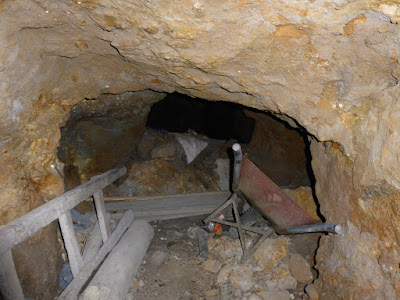The Camino de la Muerte or Road of Death is aptly named because when it was still the main road from La Paz to Coroico it had the infamous reputation of killing as many as 200 people a year. It is now really a shadow of it's former glory as all the busses and trucks travel on a paved road leaving the cliff hanging track to thrill seeking foreigners.
Water cascades off the mountain in places to add to the thrills
There are many crosses along the way as more than just a gentle reminder to go easy on the throttle
I ended up riding the road twice as the first day it was raining with heavy mist which made the riding a little more treacherous but also I never got to see the incredible views. Having unexpectedly found myself alive at the bottom of the 2000 meter descent I decided to to it again the following day when the weather was so much better.
 |
| What's wrong with this clock |
 |
The Congress Building in La Paz where the clock goes backwards. It actually runs clockwise because the numbers are in the opposite order of a conventional clock. This has been called "The Clock of the South
 |
| Wiring nightware |
 |
| Crowded Streets |
 |
| Witches Market |
A lot of woman still wear traditional clothing with the ever present bowler hat
This city of nearly a million people is situated in a valley at 3600 meters ( almost 12,000 ft ) above seal level. There are what I would call ski gondolars that ring the city ready to whisk people over the rooftops and up to the rim of the valley to avoid the incredibly congested streets. Riding my bike through the streets was hell.
 |
| View of La Paz from Alto |
Back to the tranquility of the tropical climate at the bottom of Camino de la Muerte I spent a few days in the town of Coroico - paradise
 |
| Hostel Sol y Luna |
The lush tropical climate made the beautiful gardens of Sol y Luna an amazing place to relax for a few days after the madness of LaPaz
View of the valley from Sol y Luna above the town of Coroico
After spending some time thinking on where my maps would next lead me I plotted out a route east and then north from Coroico going through the towns of Caranavi and Guanay and then to Mapiri with the intent of crossing back over the high mountains before dropping down to Lake Titicaca.
The road looked doable although both my Garmin and Google maps would for some unknown ( at the time ) reason not trace out this route. However I spoke to some local people and there was no doubt the road existed and could be done - given the right conditions.
 |
| Rio Coroico |
I climbed up out of the valley on a winding road and stopped to take a photo of the excavations going on below me. As I stopped the much anticipated but totally unexpected blast took place across the valley from me -- I nearly S**t myself !
What an amazingly beautiful ride through the jungle
 |
| Many river crossings |
 |
| Repairs needed |
I spent that night in the town of Guanay which was surrounded by lush tropical vegetation and farmlands. The next morning I awoke to light rain and mist and although I had been told that the road from here onwards could become impassable in wet weather I decided to give it a go.
For a start it was great not having to deal with any dust and the slightly damp dirt road had great traction making for some fun riding. However this changed dramatically once I started climbing higher and the rain got harder. The red clay became like a skating rink.
After the wheels became caked in clay it was almost impossible to keep the bike going in a straight line and the downhills were just downright terrifying. I finally dropped the bike and slithered to a stop covered in mud from head to toe. With a little help from a passing 4 wheel drive I got the bike upright but decided it best to turn around, especially as the huge black cloud higher up the mountain is where I was headed.
So three hours after setting out I was back in the town of Guanay just as the locals were coming out of church on Palm Sunday, all waving beautifully woven palm crosses. After a meal at a restaurant on the town square I then set out on the long road all the way back to La Paz where I arrived late that evening.
The next morning bright and early I was off to Lake Titicaca and with the help of a ferry arrived in the town of Copacabana. Yes, all you school kids who snickered at the name of this lake, it does exist and that is how you spell it.
 |
| Basilica of our Lady Copacabana |
 |
| Isla del Sol |
 |
| Inca ruins of a nunnery on Isla de la Luna |
This wall on the same site is pre - Incan. Just look at the intricate stonework with the interlocking blocks, so precise that you would be unable to slip a piece of paper between the cracks
A papyrus craft much like the one constructed by Thor Heyerdahl in the 1970's for his Ra I and Ra II expeditions ( ok you are going to have to Google that one yourselves ! )
That's it for now -- next stop Peru















































